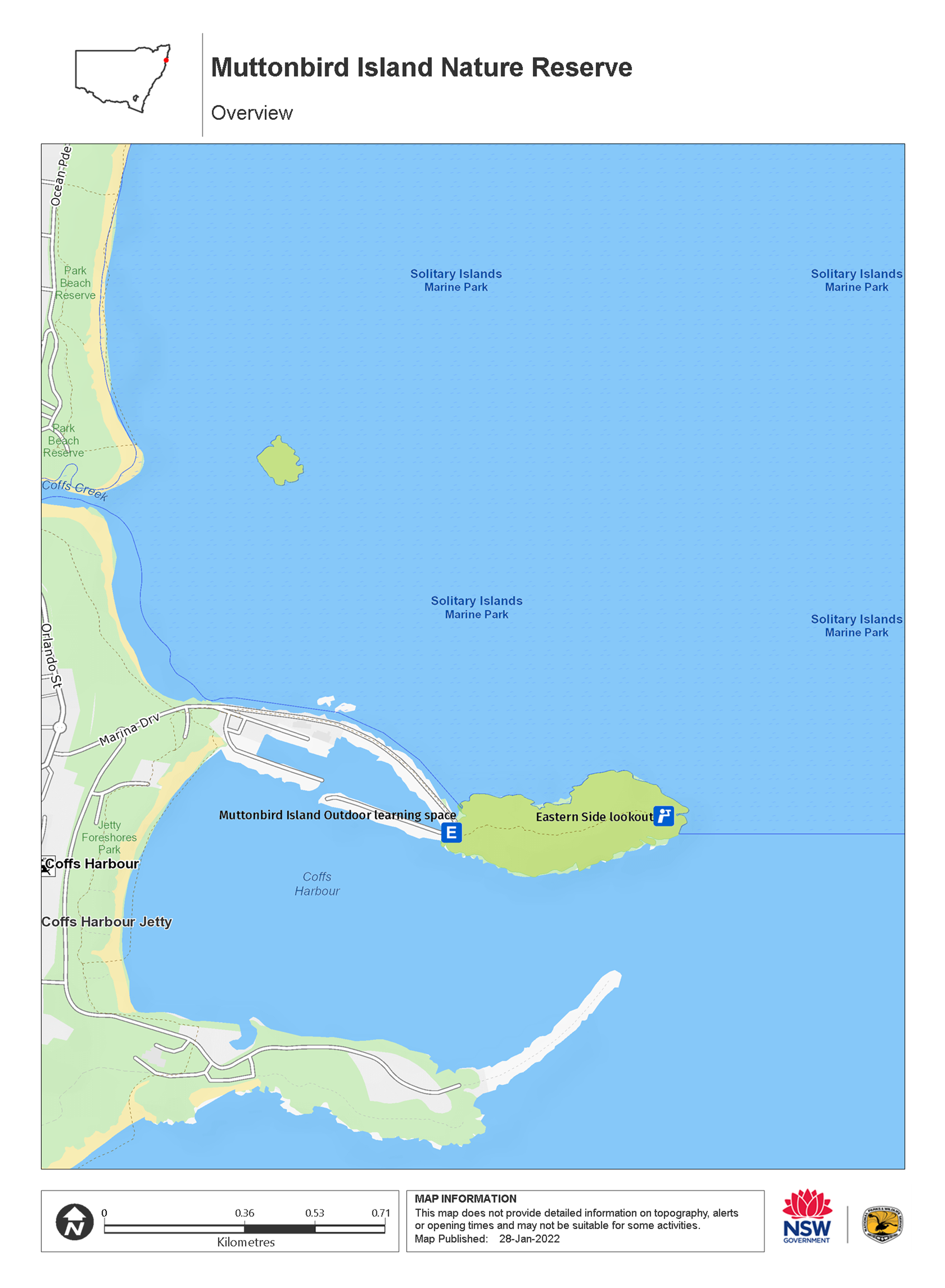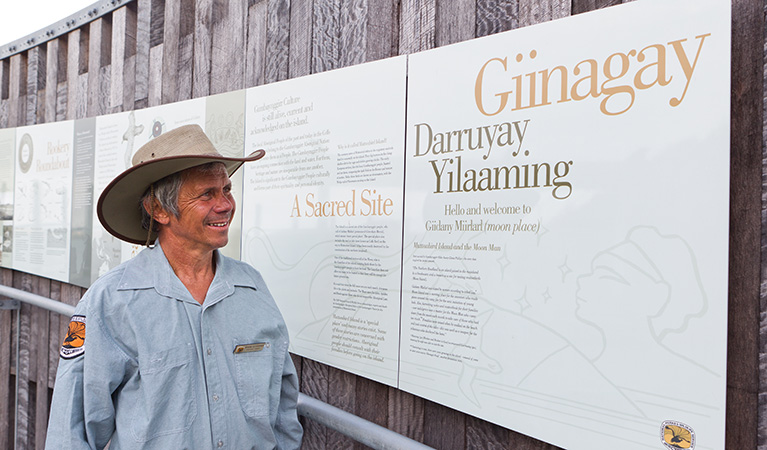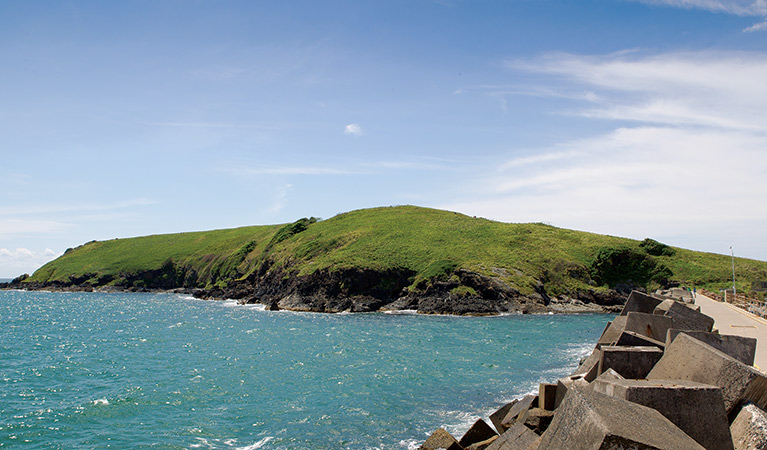Muttonbird Island Nature Reserve
Overview
The Eastern lookout offers spectacular views of the Solitary Islands. Explore the areas's Aboriginal cultural significance on a school excursion, or enjoy some whale watching in the heart of Coffs Harbour.
Read more about Muttonbird Island Nature Reserve
No visit to Coffs Harbour is complete if you haven’t been to Muttonbird Island Nature Reserve. Also know as Giidany Miirlarl, this precious seabird rookery at Coffs Harbour’s heart is enveloped by spectacular views from coast to islands.
Muttonbird Island is a great spot for watching birds up close; it’s one of the only easily-accessible places in NSW where the migratory wedge-tailed shearwater nests. It is also an important Aboriginal place, harbouring stories of the Dreaming and a wealth of traditional resources.
It’s a great place to take a short walk, and the unforgettable views will be well worth your effort. The best way to find out more about the Aboriginal stories of Muttonbird is on an award-winning guided Discovery tour conducted by local Gumbaynggirr rangers.
Take a virtual tour of Muttonbird Island Nature Reserve captured with Google Street View Trekker.
Local alerts
For the latest updates on fires, closures and other alerts in this area, see https://uat.nswparks.cloud/visit-a-park/parks/muttonbird-island-nature-reserve/local-alerts
Contact
- in the North Coast region
Muttonbird Island Nature Reserve is always open but may have to close at times due to poor weather or fire danger.
-
-
Coffs Harbour office
02 6652 0900
Contact hours: Monday to Friday, 8.30am to 4.30pm. - 4/32 Edgar St, Coffs Harbour NSW 2450
-
Email: npws.coffscoast@environment.nsw.gov.au
-
Coffs Harbour office
Visitor info
All the practical information you need to know about Muttonbird Island Nature Reserve.
Map

Map legend

Maps and downloads
Nearby towns
Coffs Harbour (4 km)
Coffs Harbour is a coastal city on the North Coast, packed with things to do. It's surrounded by lush forests and national parks.
Sawtell (12 km)
Sawtell is a beautiful town framed by beaches and a national park.
Bellingen (38 km)
Bellingen is a laid-back, tree-lined town with a New Age vibe. It's set in a luxuriant valley beside the Bellinger River.
Learn more
Muttonbird Island Nature Reserve is a special place. Here are just some of the reasons why:
Love nest

The island is home to thousands of wedge-tailed shearwaters, so called for their ability to cut or shear the water with their wings as they skim across the surface. Early settlers called them muttonbirds because of their fatty mutton-like flesh. The birds spend the Australian winter in southeast Asia, travelling back to Muttonbird Island in August each year. Amazingly, the birds return to the same burrow every year. A pair of birds share the responsibility of keeping one single egg warm and then share the raising of their chick. During the day they forage for food and return to their burrow just after dusk. They depart on their annual migration in late April every year.
- An island sanctuary self-guided audio tour SL TEST IMMERSIVE STORY CHANGE - Go on a self-guided audio tour with Matt Flanders across Muttonbird Island and discover the significance of this bustling seabird rookery. Take in the spectacular views as you stroll towards the eastern lookout and learn about the shearwaters that nest here.
- Eastern Side lookout The Eastern Side lookout offers spectacular views of the Solitary Islands. A short walk from the carpark, it’s a great place for whale watching in the heart of Coffs Harbour.
- Muttonbirds by moonlight Muttonbirds by Moonlight is an Ecosystems at risk school excursion on Muttonbird Island, a nesting rookery for wedgetail shearwaters, for Stage 6 (Years 11-12) students focusing on Geography.
- Muttonbirds by moonlight Join us at twilight for a fascinating exploration of Muttonbird Island and its nesting rookery for thousands of wedge-tailed shearwaters. This Stage 2 (Years 3-4) Geography excursion examines the features and characteristics of this unique place and environment.
- Muttonbirds by moonlight guided tour Walk the break wall path from Coffs Harbour to Muttonbird Island and join this short evening tour. You'll come up close to the birds who give Muttonbird Island its name.
Giidany Miirlarl

Muttonbird Island is a sacred and significant site to the local Gumbaynggirr Aboriginal people, who call the island Giidany Miirlarl, meaning moon sacred place. The moon is the island's protector, guarding the muttonbirds as a food source and protecting them from over-harvesting. The island was also a ceremonial site. Find out more about the cultural significance of Gumbaynggirr Country, taste bush tucker foods and learn about traditional uses of plants for medicine and shelter on a guided tour with one of the Aboriginal Discovery Rangers.
Divers delight

Muttonbird Island marks the southern boundary of the Solitary Islands Marine Park. The marine park protects coral reefs, mangroves, sea-grass beds, rockpools and river estuaries. It's a diver's paradise, a place where fish species from the tropical north and temperate south mingle among the reefs.
- Eastern Side lookout The Eastern Side lookout offers spectacular views of the Solitary Islands. A short walk from the carpark, it’s a great place for whale watching in the heart of Coffs Harbour.
- Muttonbirds by moonlight guided tour Walk the break wall path from Coffs Harbour to Muttonbird Island and join this short evening tour. You'll come up close to the birds who give Muttonbird Island its name.
Plants and animals protected in this park
Animals
-

Australian pelican (Pelecanus conspicillatus)
The curious pelican is Australia’s largest flying bird and has the longest bill of any bird in the world. These Australian birds are found throughout Australian waterways and the pelican uses its throat pouch to trawl for fish. Pelicans breed all year round, congregating in large colonies on secluded beaches and islands.
Education resources (1)
School excursions (5)
- Giidany Miirlarl: A special site, Stage 3 (Years 5-6), Science and Technology
- Muttonbirds by moonlight, Stage 6 (Years 11-12), Geography
- The rookery roundabout at Muttonbird Island, Stage 1 (Years 1-2), Science and Technology
- Giidany Miirlarl: A special site, Stage 2 (Years 3-4), Geography
- Muttonbirds by moonlight, Stage 2 (Years 3-4), Geography
What we're doing
Muttonbird Island Nature Reserve has management strategies in place to protect and conserve the values of this park. View the detailed park and fire management documents.
Preserving biodiversity
Muttonbird Island Nature Reserve strives to protect its native plants and animals from that which threatens their survival. Conservation and control measures are in operation in this park, and work to minimise impacts from visitors and introduced species. Recovery plans are implemented as required and their effects monitored carefully by NPWS staff.
Developing visitor facilities and experiences
Muttonbird Island Nature Reserve maintains its facilities and infrastructure to ensure memorable experiences. Programs to maintain, refurbish or upgrade the park’s visitor offerings are in place within this park.
Conserving our Aboriginal culture
Aboriginal culture is of great value to NPWS and the wider community, and the condition of Muttonbird Island Nature Reserve’s significant Aboriginal sites and assets is monitored and conserved. In doing this, NPWS invests in staff and contractor training and liaises with the local Aboriginal community wherever possible. NPWS review of interpretation and signage projects is ongoing.

